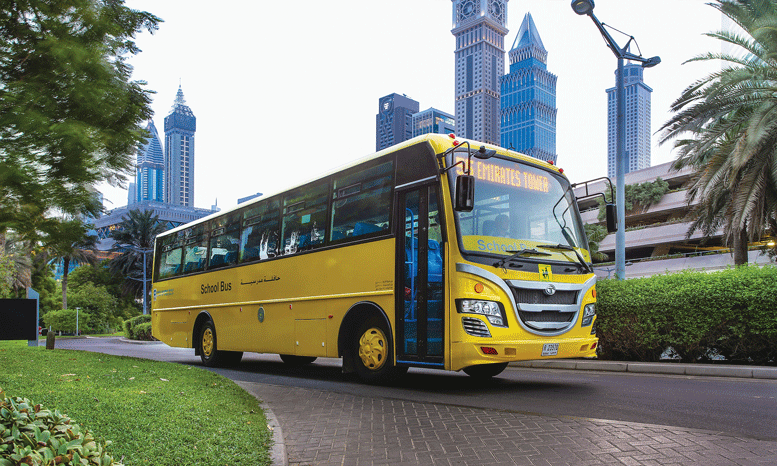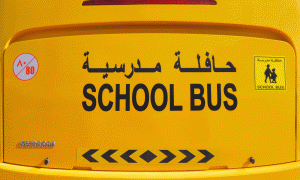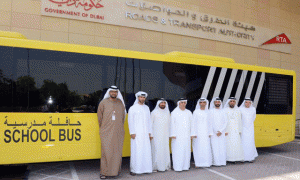Tata Motors goes back to school
Indian manufacturer has unveiled a new offering for the GCC school bus segment

The school transport segment in the GCC is certainly a promising one, if the number of bus manufacturers vying for market share in it is any indication. With the number of students in the region expected to reach 11.3 million by 2020, there’s no doubt that school transport operators stand to see significant growth, creating a valuable opportunity for commercial vehicle manufacturers to supply growing school fleets.
India’s Tata Motors has long been a mainstay of the labour transport segment in the GCC, where its buses are used daily to ferry thousands of workers to and from construction sites. The brand sells about 4,000-5,000 vehicles, predominantly buses, in the region each year.
Tata Motors has also been dominant in the school bus space, particularly within the Emirates, where it caters largely to schools serving the South Asian diaspora.
As school transport regulations gradually become more stringent in the region, however, the manufacturer saw the need for a more premium offering for the sector, with enhanced safety and comfort features.
This led to the launch of new offering for the school bus segment, specifically the Tata Elanza. While the aggregates of the bus chassis have remained the same, the Elanza has undergone a comprehensive makeover from its predecessors and boasts a brand new exterior and interior.
The bus was designed taking into account inputs from customers in the region, says Asif Shamim, regional manager – Middle East at Tata Motors. “Both private as well as government operators have played a role in helping us shape this product.”
Although the new Elanza will be gradually rolled out in the GCC, the manufacturer decided to first introduce it into the UAE market, he adds. “We wanted to bring the bus to the UAE [first] because we felt that the UAE is probably the most sophisticated market as far as regulations and such criteria are concerned for school buses. Therefore, if you can make a product that works here, you can probably have it working in other places as well.”
As promising as it may look as far as the numbers are concerned, the school bus sector comes with its fair share of challenges, particularly in terms of regulation, which largely varies across countries. Within the UAE alone, each emirate has different specifications in terms of seating capacity, layout, aisle space and so on, Tata Motors executives point out.
Tata, however, is optimistic about the prospects of the new Elanza, and has already received a major order from the UAE-based School Transport Services (STS), the largest privately owned school bus operator in the UAE.
Improvements
A key reason behind the brand’s confidence in the new bus is the overhaul in the exterior and interior, which will ensure that both driver and passengers are in for a more comfortable ride.
A new design language has been incorporated on the bus, with elements borrowed from the styling of Tata’s Prima truck range. On the front, the bus has a more curved windshield compared to its predecessors, and features Prima headlamps with projector lamps. The front flap opening of the bus has been modified, to ease access to the engine and make maintenance easier.
In addition, the entrance of the Elanza has been modified for easier ingress, and steps have been broadened to enable students to climb into the bus more easily. Inside the bus, the cushioning of the seats has been improved for greater comfort, and a skid-resistant vinyl floor has been added.
According to Tata Motors, the Elanza also features better cladding and more sound-proofing to reduce noise levels inside the bus.
The Elanza meets all Dubai RTA school bus norms and comes with a whole host of safety and comfort features, backed by the reliability of the Tata driveline.
Strategy
The new bus will first be revealed to UAE school customers at a launch event this month. While Tata Motors does plan to eventually target other GCC markets as well, it will focus on the Emirates for now.
As the bus is largely modified and tailored to suit each school customer’s requirements, its final price will depend on the specifications required by the customer, he says. “School buses are not retail products. You don’t keep them in the showroom for sale off the shelf. They are ordered depending on the school’s requirements. The price will really depend on what you want from the product.”
Customers have several options for financing, which is readily available, as we work with a lot of Commercial Vehicle Financiers.
Looking ahead, Tata Motors is keen on dominating the school bus segment, once the new Elanza hits the roads despite the stiff competition from other Indian and Chinese competitors, he concludes.
“We want to be the leading brand in the school transport space, with the Elanza. If we want to be the leading brand, then we need to be competitive. And that’s something that we’re committed to being.”















